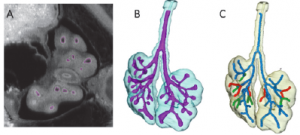 基盤S合宿2016が行われました(2016.8.25-26;三浦半島)
基盤S合宿2016が行われました(2016.8.25-26;三浦半島)
大変有意義な議論ができました。
|
||||
|
第56回日本先天異常学会(2016/7/29-31)にて、白石さんが「2016年度日本先天異常学会奨励賞」を受賞しました。 「ヒト胚子期における脳形成の形態計測学的解析」 MRIdataを用いてヒト胚子期の脳形成を立体的に観察、計測しました。(Neuroimage 2015) 、修士終了後もデータの整理、論文作成を継続し、成果に結びつけました。おめでとうございます。 3題のポスター発表を行いました。 石山 華、山田 重人、上部千賀子、米山 明男、武田 徹、今井 宏彦、松田 哲也、高桑 徹也:ヒト後腎形態形成の 3 次元的解析 村中 太河、山田 重人、上部千賀子、米山 明男、武田 徹、 巻島 美幸、高桑 徹也:ヒト胚子期における気管支分岐形成の三次元的、数理的解析
小林さんの卒論がPrenatal Diagnosisに掲載されました。ヒト胚子期の標本を用いて脳の発生に伴う計測値の変化、特徴を論じたものです。
得られた結果は、超音波データの修正と比較、出生前診断の改善に貢献することが期待されます。 また、同号の表紙にも採用されました。 23. Kobayashi A, Ishizu K, Yamada S, Uwabe C, Kose K, Takakuwa T, Morphometric human embryonic brain features according to developmental stage, Prenatal Diagnosis, 36:338–345, 2016, DOI: 10.1002/pd.4786. DOI: 10.1002/pd.4818 AbstractObjectivesThe present study investigated linear, area, and volume measurements of human brain samples according to Carnegie stages (CS) in an attempt to select suitable morphometric features that reflect embryonic development. MethodsUsing magnetic resonance imaging, we measured seven linear segments, three separate areas, and three regional volumes in 101 samples between CS13 and 23. Brain volume was determined via manual segmentation of the magnetic resonance image, whereby a formula was generated to estimate the volume of each linear measurement. ResultsAll parameters correlated with crown-rump length. Bitemporal length and mesencephalic height increased linearly according to the CS, and a high correlation between bitemporal length and both whole-brain (r = 0.98) and prosencephalon (r = 0.99) volumes was found when brain cavity volume was excluded. ConclusionMorphometric data related to human embryonic stages are valuable for correcting and comparing sonographic data. The present approach may contribute to improvements in prenatal diagnostics by enabling the selection of more suitable measurements during early embryonic stages. 上野さんの修論がAnat Recに掲載されました。 Somite stageの胚(CS11-13, 28-33日, 21−35体節)における消化管由来原基の形態と分化のTimeLineを検討
今後、消化管関連の異常発生の検出等に有用と考えられます。 22. Ueno S, Yamada S, Uwabe C, Männer J, Shiraki N, Takakuwa T, The digestive tract and derived primordia differentiate by following a precise timeline in human embryos between Carnegie stages 11 and 13, Anatomical Rec 2016, 299(4), 439-449, DOI: 10.1002/ar.23314 ABSTRACTThe precise mechanisms through which the digestive tract develops during the somite stage remain undefined. In this study, we examined the morphology and precise timeline of differentiation of digestive tract-derived primordia in human somite-stage embryos. We selected 37 human embryos at Carnegie Stage (CS) 11–CS13 (28–33 days after fertilization) and three-dimensionally analyzed the morphology and positioning of the digestive tract and derived primordia in all samples, using images reconstructed from histological serial sections. The digestive tract was initially formed by a narrowing of the yolk sac, and then several derived primordia such as the pharynx, lung, stomach, liver, and dorsal pancreas primordia differentiated during CS12 (21–29 somites) and CS13 (≥ 30 somites). The differentiation of four pairs of pharyngeal pouches was complete in all CS13 embryos. The respiratory primordium was recognized in ≥ 26-somite embryos and it flattened and then branched at CS13. The trachea formed and then elongated in ≥ 35-somite embryos. The stomach adopted a spindle shape in all ≥ 34-somite embryos, and the liver bud was recognized in ≥ 27-somite embryos. The dorsal pancreas appeared as definitive buddings in all but three CS13 embryos, and around these buddings, the small intestine bent in ≥ 33-somite embryos. In ≥ 35-somite embryos, the small intestine rotated around the cranial-caudal axis and had begun to form a primitive intestinal loop, which led to umbilical herniation. These data indicate that the digestive tract and derived primordia differentiate by following a precise timeline and exhibit limited individual variations.
2015年度”次世代医療を語る -再生医療の実用化に向けて”全14回がDVDになりました。医学部図書館等で閲覧可能です。(非売品) CiRA, 京大病院、民間企業の研究者他、豪華講師陣です。 (AMEDの助成を受けました)
尾関さんの修士論文のうち、ヒト外耳の形態形成に関する内容がCongenit Anom (日本先天異常学会誌)に受諾されました。500例以上の外耳観察の成果です。
21. Ozeki-Sato M, Yamada S, Uwabe C, Ishizu K, Takakuwa T, Correlation of external ear auricle formation with staging of human embryos, Congenit Anom (Kyoto) 56, 86-90, 2016, DOI: 10.1111/cga.12140, . (概要), AbstractThe formation of auricles in human embryos was evaluated between Carnegie stage (CS)19 and CS23, and the findings were correlated across the stages. The auricle was categorized into 11 steps according to Streeter’s criteria with modifications. Mesenchyme cell condensation was observed at Step 7, and two layers of cartilage consisting of the auricle were recognized at Step11. The representative steps at each CS shifted from Step 3 to Step11 during CS16 and CS23, although several steps overlapped between adjacent CSs. These results indicate that observations of the auricle between CS19 and CS23 may be utilized for determining embryo staging as convincing supportive evidence of external features reflecting the internal histological structure, although other findings should also be taken into account.  気管支分岐の法則性について 新学術領域研究「多元計算解剖学」第2回 国際シンポジウムで発表しました。 Three-dimensional Analysis of the Bronchial Branching in Human Embryonic Stages Takakuwa T, Muranaka T, Yamada S
日時:平成28年2月11日 (木・祝)9:00~18:00 2月12日 (金) 9:00~16:50 場所:名古屋大学 野依記念学術交流館 2階 |
||||